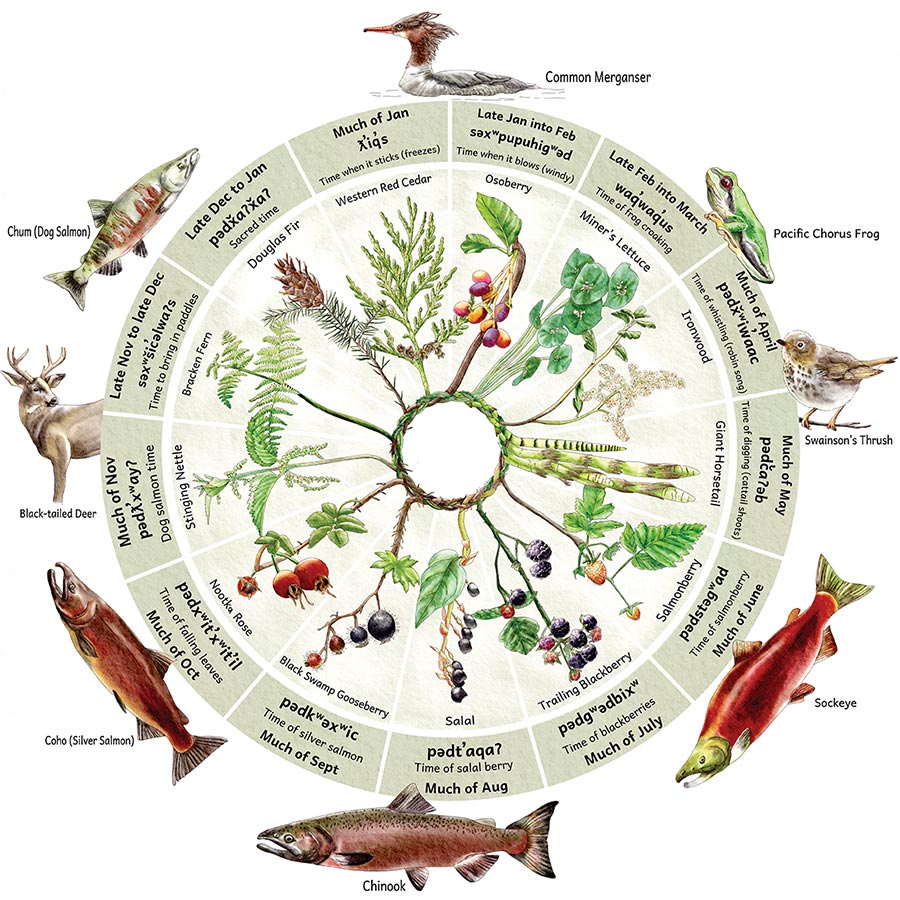Observing Planet Earth
Weather, climate, and environmental data has been collected by peoples orally, in written form, and via technology for centuries, forming a natural history of our planet.
Observing the Pacific Northwest For Thousands of Years
The Coast Salish People, indigenous to western Washington, who have lived here since the last ice age are expert phenologists. They observe the weather and seasons using the signals of the moon phases and the emergence of specific plants, insects, or animals to track seasonal cycles. These cycles inform their activities throughout the year - from the arrival of spawning salmon to when to harvest roots or berries. This tradition of environmental observation, developed over thousands of years is often described as the "Seasonal Round."

This seasonal round, created by Robin Bundi, was commissioned by Skagit Land Trust to display at the Marblemount Conservation Area, which is located on the traditional territory of the Upper Skagit and Sauk-Suiattle Tribes. The round references the 13 moons lunar calendar, versions of which are used by the Upper Skagit, Sauk Suiattle and other Coast Salish Tribes. Lushootseed words (the language common to these tribes) and their meanings reflect the important activity or event that occur during those times of the year.
Learn More about the Coast Salish calendar as described in the Seasonal Round from the Samish Indian Tribe's 13 Moons calendar story map.
Weather Journals & Field Journals
A selective history of written weather data in the Pacific Northwest.
A Brief History of Seattle Weather Observations
The first written record of Seattle Weather Observations began on February 16, 1870, recorded by James E. Whitworth, a Seattle businessman and son of the third President of the Washington Territorial University (now known as the University of Washington) and founder of Whitworth College. Whitworth collected his weather observations from his home near 3rd Avenue and Yesler Way and kept records at least until December 1871. Those records are known because Whitworth sent his records to The Smithsonian.
Weather observations were recorded at a handful of locations in or near Seattle before the establishment of the Weather Bureau in 1891. The Weather Bureau, which eventually became the National Weather Service, began weather observation records in Seattle on May 1, 1893. Official observations began at Sea-Tac International Airport in November 1948.
Learn More about the History of Seattle Weather Observations from the Midwestern Regional Climate Center's The History of Weather Observations, Seattle, WA 1870 - 1948, by Glen Conner.
Modern Weather & Climate Observations
Over time, the equipment used by the National Weather Service to collect weather and climate data has changed. The quality, timeliness, and density of observation information are critical to ensuring accurate forecasts and issuing life-saving weather warnings during extreme weather events. Some sources of these observations include:
-
Twice a day, from over 90 locations across the United States, the National Weather Service launches weather balloons carrying instrument packages called radiosondes to measure upper-air conditions, including atmospheric pressure, temperature, humidity, and wind speed and direction. There are two launch locations in Washington State; Spokane and Quillayute (near Forks).
-
Automated weather reports from commercial aircraft have been an important data source for numerical weather prediction models for decades. Data measured from these aircraft include air pressure, air temperature, and wind speed, as deduced from knowledge of the airspeed and groundspeed.
-
Remote sensing equipment is used in the detection and measurement of weather phenomena with devices sensitive to electromagnetic energy such as Doppler Radar and weather satellites.
Learn More about these and other weather data collection technologies, from the National Weather Service.
Understanding Climate Requires Observing More Than Just the Weather
The Story of El Nino
 December is peak anchovy fishing for Peru. But, every once and a while, boats returned
to shore with empty nets and disappointed fishermen. These fishermen noticed that
the lack of anchovies coincided with warmer-than-usual water temperatures. In the
1600s, the phenomenon became known as "El Niño de Navidad," which translates to "The
Christmas Child" because it occurred during the Christmas season.
December is peak anchovy fishing for Peru. But, every once and a while, boats returned
to shore with empty nets and disappointed fishermen. These fishermen noticed that
the lack of anchovies coincided with warmer-than-usual water temperatures. In the
1600s, the phenomenon became known as "El Niño de Navidad," which translates to "The
Christmas Child" because it occurred during the Christmas season.
These days, tracking El Nino is not just about the anchovies. Scientists monitor sea surface temperatures, sea surface height, and wind patterns using a combination of ocean buoys and satellites.
What was initially understood as a local climate pattern affecting the South American Anchovy fisheries is now recognized as a global climate pattern. The unusually warm waters, coupled with slower trade winds in the equatorial Pacific, lead to a drop in air pressure in the central tropical Pacific, impacting weather around the world.
Learn more about El Nino from UCAR's An El Niño Fish Tale, and NOAA's El Niño: A Historical Perspective.
What Can You Do?
Observing Our Planet - The Importance of Field Journals
Whether in the field or at sea, scientists, explorers, farmers, and global citizens have observed and recorded their observations of our planet for hundreds of years. Journals can be formal like the ship's log from Shackleton's Endurance, to Thomas Jefferson's Farm Book, to Joseph Grinnell's protocol for recording field observations, to something more fun like Comics At Sea: An Antarctic Logbook.
Start Your Own Nature Journal
You can start your own field journal! Keeping a nature journal helps us build our connection to the natural world we live in, and heightens our awareness of how the natural world is changing from day to day, season to season, and year to year. Here are a couple of resources to get you started:
- If you want to keep a scientific type of journal, you can use the North Cascades Institute Blog about The Field Journal of a Naturalist: Grinnell Journaling in the North Cascades to get started.
- If you want to start a journal to explore your thoughts, feelings, ideas, activities, observations, and relationship with the natural world,check out How To Start A Nature Journal from the Sierra Club.
- If you want to practice your art in conjunction with your observations of the planet, check out Drawing Science: Field Sketching for Beginners from Juneau Empire.

